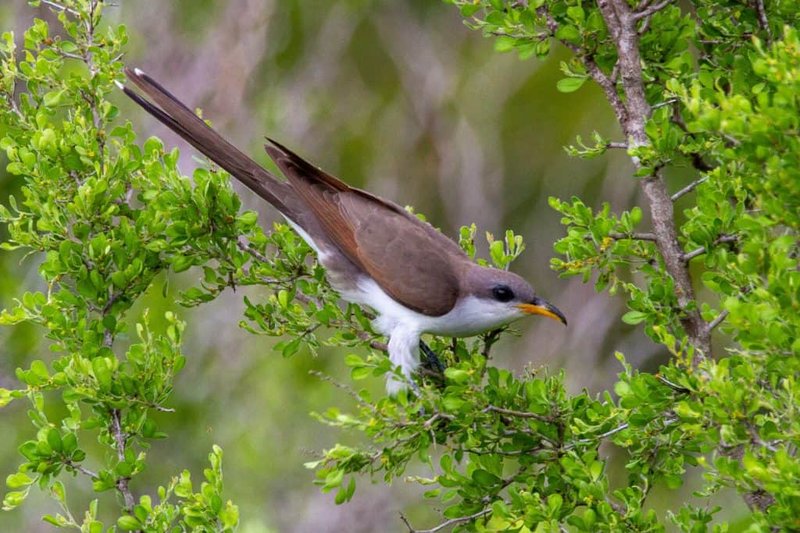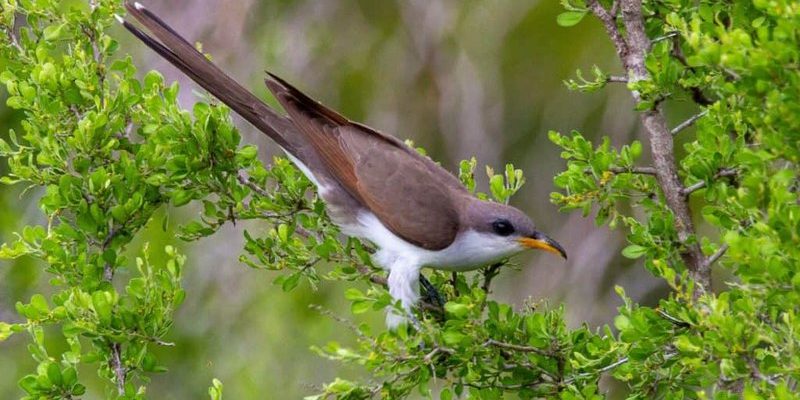
The Yellow-Billed Cuckoo is a bird that might not be the first one you think of when you picture avian beauty, yet it has a charm all its own. With its striking yellow bill and melodious call, the yellow-billed cuckoo holds a special place in the hearts of bird watchers and nature enthusiasts alike. Imagine sitting in a quiet forest, the sun peeking through the leaves, when suddenly, you hear its distinctive cooing. It’s a sound that seems to wrap around you like a warm blanket, inviting you into the world of these fascinating creatures.
You might be wondering what sets the Yellow-Billed Cuckoo apart from other birds. For starters, its unique feeding habits and migratory patterns make it a subject of interest among researchers. This bird spends its summers in North America, particularly in canopied forests and riparian zones, and migrates south for the winter. In this article, we’ll explore its characteristics, behaviors, and the vital role it plays in the ecosystem.
Physical Characteristics
The first thing you might notice about the yellow-billed cuckoo is its eye-catching plumage. These birds are medium-sized, averaging about 11 to 12 inches in length, with a wingspan of around 14 to 15 inches. They have a brownish-gray back, white underparts, and, intriguingly, a bright yellow bill that gives them their name. You know how certain animals seem to have personality traits that match their looks? The yellow-billed cuckoo’s striking appearance has a sort of whimsical charm that fits its behavior perfectly.
Their long tail is another standout feature, often marked with white spots that create a beautiful pattern when they’re in flight. The combination of colors provides excellent camouflage against the leafy backdrop of their forest habitat. But why is this important? Well, this natural disguise helps protect them from predators, allowing them to live a life more free of danger.
Beyond looks, these birds have specialized adaptations that enable them to thrive in their environments. Their long, slender bodies are designed for agile flight through dense foliage, making them skilled at navigating through trees and shrubs—essential skills when you’re dodging both predators and obstacles in the wild.
Habitat and Distribution
The yellow-billed cuckoo is typically found in North America during the breeding season, with a habitat preference for areas that offer dense vegetation. They particularly enjoy riparian zones, which are lush areas alongside rivers and streams, as well as deciduous forests. These habitats are rich in insects—a major part of their diet—making it a perfect home for them. You might see them flitting about in willows, cottonwoods, and even in suburban gardens with enough cover.
When winter approaches, the yellow-billed cuckoo begins its migratory journey to Central America and northern South America. Isn’t it fascinating how these birds travel such long distances? They can cover thousands of miles! This migration typically takes place from late August to early October. During this time, they seek warmer climates where food is plentiful, allowing them to survive the winter months.
In recent years, their population has seen some challenges. Habitat loss due to urbanization and agricultural practices has put pressure on their breeding grounds. Conservation efforts are critical to ensuring that these beautiful birds continue to thrive in their natural environments.
Diet and Feeding Behavior
The yellow-billed cuckoo has developed quite the appetite for certain types of food, mainly focusing on insects. Their diet consists largely of caterpillars, grasshoppers, and various moths. You might be surprised to learn that they have a particular taste for the pesky tent caterpillar, which makes them a great ally for gardeners! What’s more, they sometimes eat small fruits. It’s akin to treating themselves to a little dessert after a hearty meal.
One of the most interesting things about these cuckoos is their unique feeding style. They employ a technique known as “gaping.” This means they open their beaks wide to catch insects on the wing or to snag them off foliage. It’s almost like they’re playing a game of catch, and the insects don’t stand a chance. Watching them in action is a real treat, and it’s one of the many reasons birdwatchers love observing them.
While feeding, yellow-billed cuckoos often forage alone or in pairs, although during migration, they might join small flocks. Their keen eyesight helps them spot food hiding amongst the leaves, and their nimble flight allows them to dart quickly from branch to branch. It’s a charming scene to witness—nature at work!
Behavior and Breeding Habits
When it comes to behavior, yellow-billed cuckoos are generally solitary, but they become more social during the breeding season. Males are known for their distinct calls, which serve to attract females and establish territory. You know how some birds have calls that sound like music? The yellow-billed cuckoo’s call is simple and soothing, resembling a series of cooing notes. It’s a delightful sound that adds to the chorus of the forest.
As the breeding season approaches, courtship rituals begin. Males often engage in displays consisting of fluttering flights and calling to impress potential mates. Once a pair forms, they work together to build a nest, typically located in the dense foliage of trees. They prefer to nest in low shrubs, which provides cover from predators.
After laying about 2 to 6 eggs, both parents take turns incubating them for about 10 to 14 days. Once hatched, the chicks are altricial, meaning they are born relatively helpless and rely on their parents for food and protection. The young cuckoos fledge approximately 17 to 20 days after hatching, and it’s during this time they start to learn the ropes of survival, including how to forage for their own meals.
The Role of Yellow-Billed Cuckoos in the Ecosystem
The yellow-billed cuckoo plays a critical role in maintaining the ecological balance of its habitat. As a consumer of insects, it helps regulate populations of pests that could otherwise become overwhelming. Think of them as natural pest controllers! This ecological service not only benefits the plants and trees in their environment but also contributes to the wellbeing of other animals that share the same habitat.
Moreover, their migration patterns can indicate the health of ecosystems. Because these birds are sensitive to changes in habitat and climate, monitoring their populations can help scientists track broader environmental changes. If the yellow-billed cuckoo is thriving, it often reflects a healthy ecosystem—like a barometer for nature. However, if their numbers decline, it can signal underlying issues that may need addressing.
In addition, when yellow-billed cuckoos migrate, they contribute to seed dispersion and overall plant growth in their wintering grounds. This means that every migration helps promote biodiversity, making them an essential player in their ecosystems. Their existence is a beautiful reminder of the interconnectedness of nature.
Conservation Status
As charming as the yellow-billed cuckoo is, it’s essential to recognize its conservation status. Currently, these birds are classified as near threatened in some regions due to habitat loss. Urban development, deforestation, and agricultural expansion have significantly impacted their breeding and feeding grounds. This isn’t just a threat to the yellow-billed cuckoo; it has ripple effects on the entire ecosystem.
Conservation groups are working hard to protect habitats that these birds rely on. This effort includes restoring areas of native vegetation and promoting sustainable agricultural practices that do not disrupt their homes. It’s much like giving these cuckoos a safe haven in a rapidly changing world. You might feel a sense of urgency knowing how critical their survival is for ecological balance.
By participating in local conservation efforts, whether through supporting organizations or simply creating bird-friendly spaces in your backyard, you can help protect these beautiful creatures. The more we understand the challenges they face, the better equipped we will be to help. It’s a collective effort that reflects our shared responsibility for the environment.
Interesting Facts about Yellow-Billed Cuckoos
| Scientific Name | Coccyzus americanus |
| Size | 11-12 inches in length |
| Wingspan | 14-15 inches |
| Diet | Insects, caterpillars, and fruits |
| Nesting Habits | Nests in dense vegetation, typically low shrubs |
| Migratory Patterns | Breeds in North America, migrates to Central and South America for winter |
| Call | A distinctive series of cooing notes |
FAQ
What do Yellow-Billed Cuckoos eat?
Yellow-billed cuckoos primarily feed on insects such as caterpillars, grasshoppers, and various moths. They also enjoy small fruits at times. Their diet heavily relies on the availability of insects in their habitat, making them effective natural pest controllers.
Where can I find Yellow-Billed Cuckoos?
During the breeding season, yellow-billed cuckoos are commonly found in North America, especially in areas with dense vegetation like riparian zones and deciduous forests. In winter, they migrate to Central and South America, escaping the colder climates of the north.
How do Yellow-Billed Cuckoos migrate?
The yellow-billed cuckoo migrates in flocks, typically traveling long distances from their breeding grounds in North America to warmer regions in Central and South America. This migration occurs between late August and early October, showcasing their remarkable navigational skills.
Are Yellow-Billed Cuckoos solitary or social birds?
Yellow-billed cuckoos are generally solitary birds, especially when feeding. However, during the breeding season, males become more social as they call to attract mates and establish territory. They may form small groups during migration.
What threats do Yellow-Billed Cuckoos face?
The primary threats to yellow-billed cuckoos include habitat loss due to urban development, agriculture, and deforestation. These changes in the environment can lead to declining populations and make their survival more challenging.
What is the breeding behavior of Yellow-Billed Cuckoos?
During the breeding season, yellow-billed cuckoos build nests in dense vegetation, where females lay about 2 to 6 eggs. Both parents take turns incubating the eggs and caring for the chicks once they hatch, teaching them vital survival skills.
Do Yellow-Billed Cuckoos make good pets?
While yellow-billed cuckoos are fascinating birds, they are not suitable as pets. They have specific habitat needs and feeding requirements that are best met in the wild. Additionally, keeping wild birds as pets may be illegal in some areas.
Can Yellow-Billed Cuckoos mimic other birds?
Unlike some other cuckoo species, yellow-billed cuckoos do not mimic the calls of other birds. However, their unique cooing call is distinctive and recognizable, making them easier to identify in their natural environment.
How long do Yellow-Billed Cuckoos live?
In the wild, yellow-billed cuckoos have an average lifespan of about 2 to 3 years, although some individuals have been known to live longer. Factors such as predation, environmental conditions, and food availability can influence their lifespan.
What can I do to help conserve Yellow-Billed Cuckoos?
You can support conservation efforts by creating bird-friendly spaces in your yard, using native plants that attract insects, and participating in local conservation initiatives. Educating others about the importance of protecting these birds and their habitats is also valuable.

